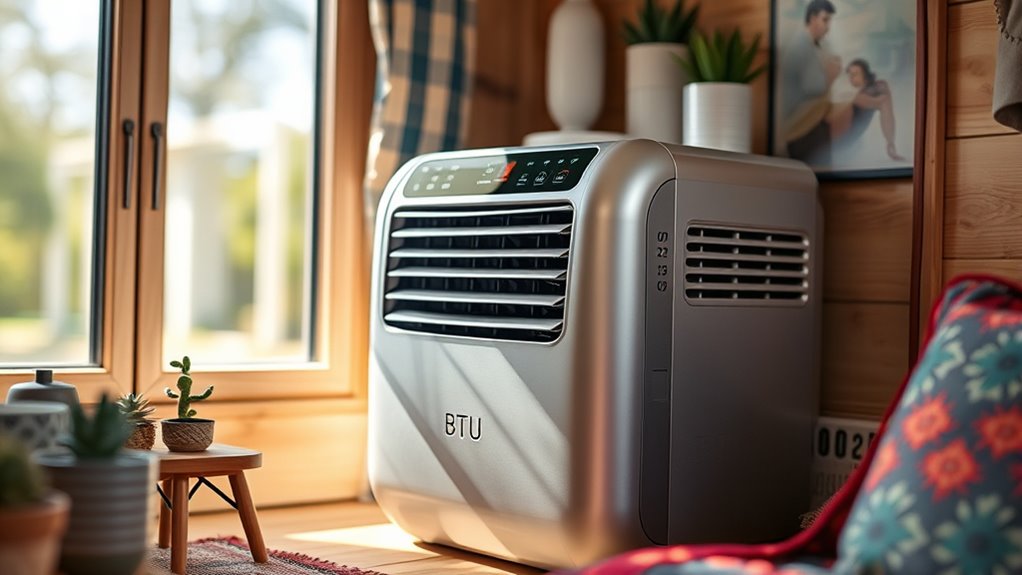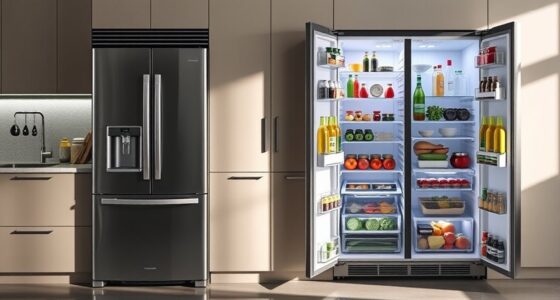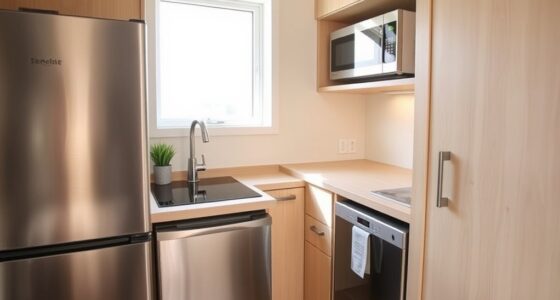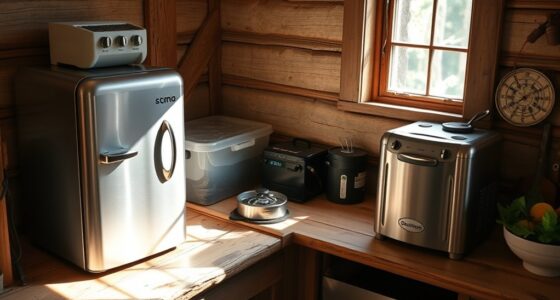Choosing a portable AC for your tiny house depends on matching the BTU rating to your space size and insulation. Usually, 6,000–8,000 BTUs work well for small rooms, but larger or sunlit areas may need more. It’s important to contemplate energy efficiency standards like SACC ratings, which reflect real-world performance. If you want a comfortable, efficient setup, understanding these details will help you pick the right unit—more tips are just ahead.
Key Takeaways
- Choose portable AC units with 6,000–8,000 BTUs for small tiny houses up to 250 sq. ft. for efficient cooling.
- Proper sizing prevents overcooling or underperformance, ensuring comfort and energy efficiency in tiny spaces.
- RIGID portable AC units are ideal for tiny houses, offering easy installation without window modifications.
- Ensure proper placement near windows and ventilation outlets to maximize cooling and airflow in confined tiny house spaces.
- Regular maintenance and correct BTU selection help tiny house owners achieve optimal comfort and energy savings.
Understanding BTU Ratings and Cooling Power
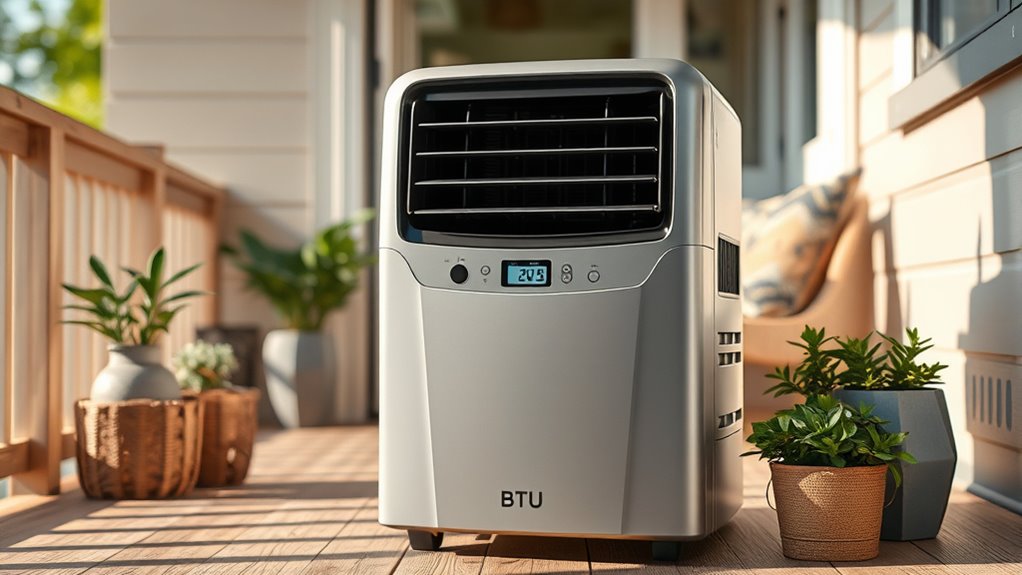
Understanding BTU ratings is essential when choosing a portable AC unit because they directly indicate the device’s cooling capacity. A BTU, or British Thermal Unit, measures how much thermal energy the AC removes per hour. The higher the BTU, the more cooling power you get, especially for larger or hotter spaces. It’s a critical factor because it determines how effectively the unit cools your area. Manufacturers and regulators use BTU ratings to label units clearly. Keep in mind, though, that industry standards like ASHRAE often overestimate real-world performance. SACC ratings, introduced by the DOE, offer a more accurate picture by considering real-life conditions, helping you better predict how the unit will perform in your home. Additionally, understanding the benefits of high BTU ratings can help ensure you select a unit that adequately cools your space without unnecessary energy consumption.
Matching BTU Ratings to Tiny-House Size
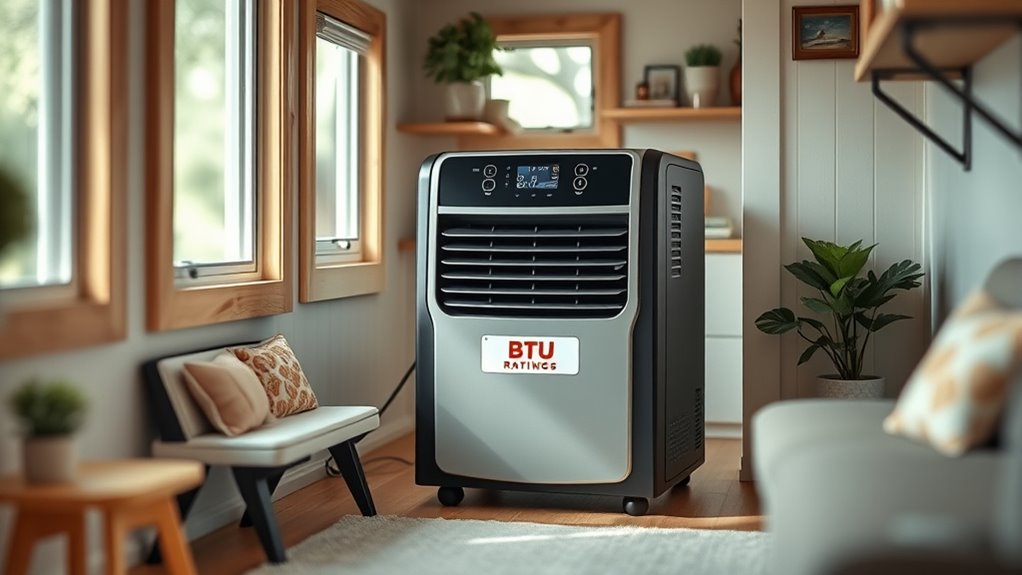
Choosing the right BTU rating depends on your tiny house’s size and layout. A unit that’s too small won’t cool effectively, while one that’s too large wastes energy and costs more. To get it right, match your space’s square footage with the appropriate BTU range for best comfort and efficiency. Additionally, considering signs of spoilage in your cooling unit, such as unusual noises or odors, can help maintain optimal performance.
Appropriate BTU Range
Matching the BTU rating of your portable AC unit to your tiny house’s size is essential for effective cooling and energy efficiency. For spaces around 100 to 250 square feet, a unit with 6,000 to 8,000 BTUs typically works well. Smaller spaces, like closets or single rooms, may only need about 5,000 to 6,000 BTUs. If your tiny home is larger or has higher ceilings, you might need up to 10,000 or even 14,000 BTUs. Keep in mind that factors such as sunlight, occupancy, and insulation can increase cooling needs, so choosing a slightly higher BTU rating can help. Additionally, properly sizing your AC ensures optimal performance and prevents unnecessary energy use. Avoid oversizing, as it wastes energy and leads to inefficient operation. BTUs indicate how much heat is removed, not produced. Matching BTU ratings accurately guarantees comfort without unnecessary power consumption.
Room Size Alignment
Accurately matching the BTU rating of your portable AC to your tiny house’s size guarantees effective cooling without wasting energy. Measure your space in square feet by multiplying length and width. For tiny houses, typically 100 to 400 sq. ft., a unit between 5,000 and 10,000 BTU works well. For example, a 300 sq. ft. tiny house fits with a 6,000–7,000 BTU AC. Oversized units can cause overcooling and humidity issues, while undersized ones struggle during peak heat. Consider insulation, sun exposure, and layout—open plans or poor insulation increase cooling needs. Properly aligned BTU ratings ensure comfort, energy efficiency, and the longevity of your portable AC, making sure you stay cool without excess power use. Matching the BTU to your specific climate conditions can further optimize performance and energy savings. Additionally, understanding wilderness survival gear can be beneficial if you plan to camp or live off-grid, ensuring you are prepared for various situations.
The Significance of Energy Efficiency Standards
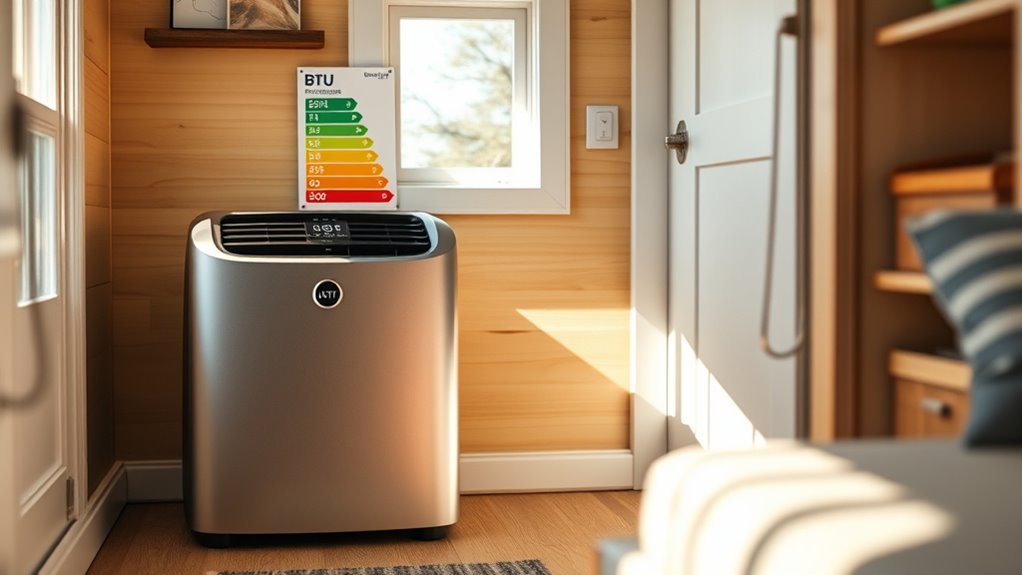
Energy efficiency standards play a crucial role in reducing energy consumption and lowering environmental impact. Over the past 33 years, DOE standards have helped room air conditioners use 39% less energy than models from 1990. These standards have been raised three times, driving innovation and consumer savings—projected at $25 billion over 30 years. For portable AC units, new rules set in 2016 aim for a 27% boost in energy savings while maintaining cooling performance. The standards also cut greenhouse gases by over 2.4 billion metric tons during this period. By enforcing stricter efficiency metrics like EER and CEER, these standards help you choose units that save money and reduce environmental impact. They also promote technological advancements that benefit consumers and the planet alike. Implementation of fraud detection software is essential for maintaining transaction security and preventing fraud.
Comparing ASHRAE and SACC Ratings for Real-World Performance
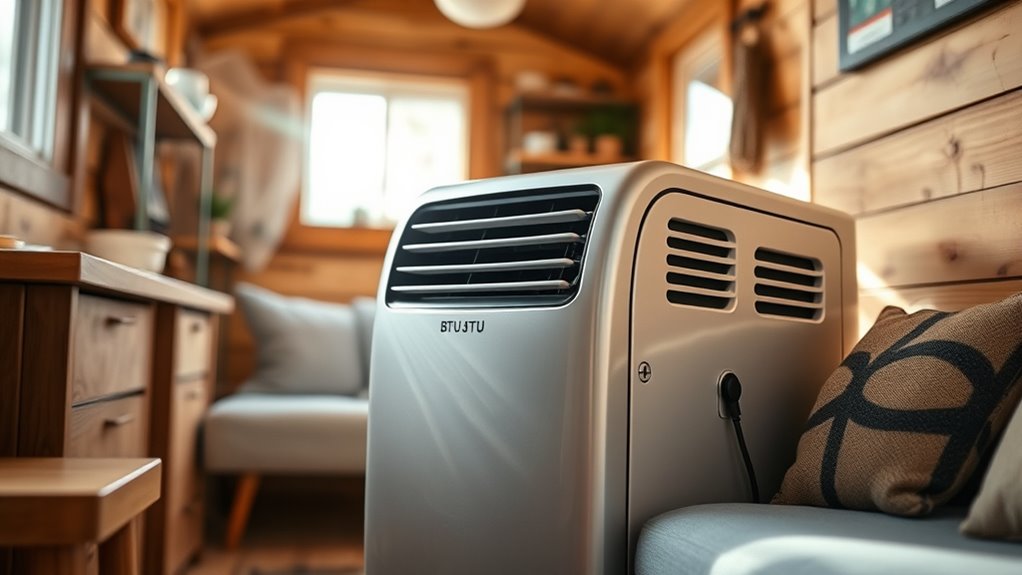
Understanding the differences between ASHRAE and SACC ratings is essential because they measure portable AC performance under different conditions. ASHRAE ratings come from lab tests in ideal conditions—80°F, 50-51% humidity, with minimal external heat. In contrast, SACC ratings account for real-world factors like outdoor temperatures, higher humidity, heat infiltration, and inefficiencies from exhaust systems. As a result, ASHRAE ratings tend to be higher, often overestimating actual cooling capacity. This discrepancy helps you understand that real-world performance is lower than lab-rated figures, making SACC ratings more reliable when sizing units for your tiny house or small space. Relying solely on ASHRAE ratings can lead to overestimating cooling needs. Understanding testing conditions affects the accuracy of each measurement.
Selecting the Right Portable AC for Small Spaces
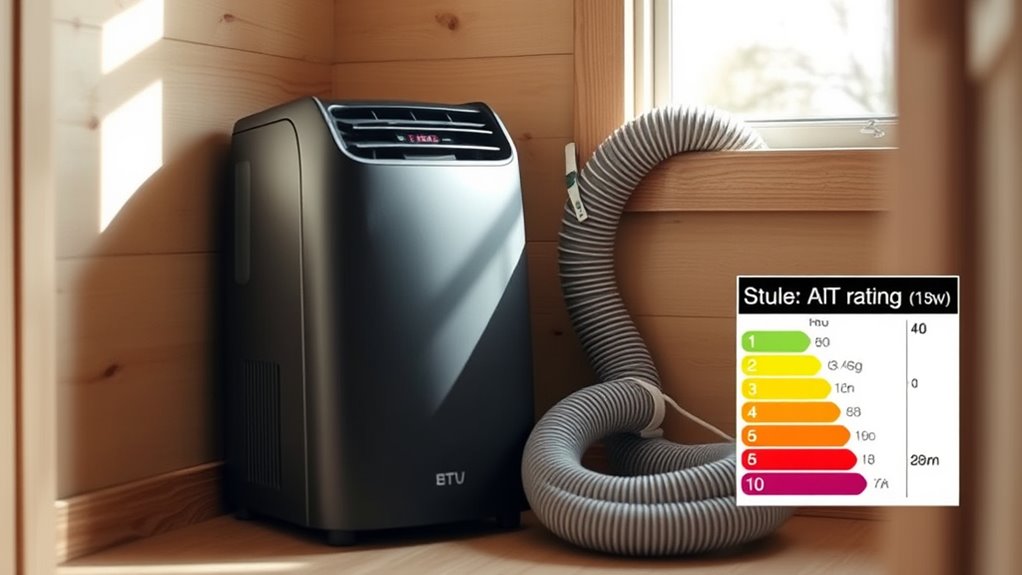
Choosing the right portable AC for small spaces starts with matching the unit’s BTU rating to the size of your room. For spaces around 150–250 sq. ft., a 6,000 BTU unit typically suffices. To find the right size, multiply your room’s length by its width to determine its square footage. Remember, lower BTUs are ideal for tiny houses, RVs, or small bedrooms, ensuring efficient cooling without wasting energy. A unit with a high EER rating (at least 10) improves energy efficiency, saving you money over time. Avoid oversized units, which can cycle on and off excessively, reducing effectiveness and increasing energy use. Focus on units that are compact, lightweight, and easy to move, especially if space is limited. Proper sizing guarantees comfort and peak performance in small spaces. Additionally, selecting units with energy-efficient features can further enhance long-term savings and environmental impact.
Space Constraints and Portable AC Solutions
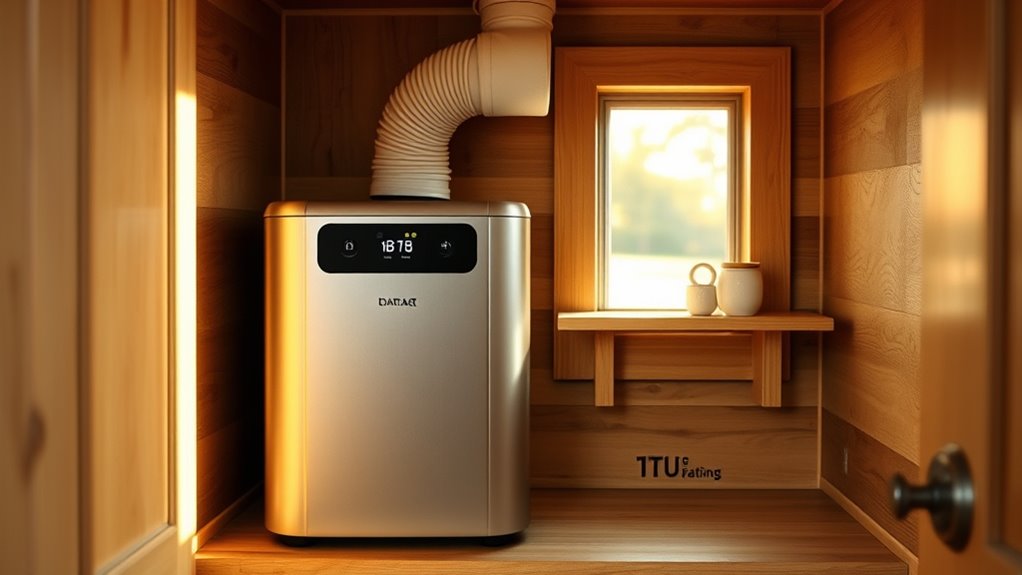
Space constraints in tiny houses considerably influence how you can position and vent portable AC units. With sizes typically between 100 and 400 square feet, you need compact solutions that don’t take up much floor space. Limited wall and window areas mean venting can be tricky; flexible hoses or specialized kits help adapt to small or unconventional openings. Furniture and storage reduce available space, so slim or multi-functional units work best. Low ceilings impact airflow and cooling efficiency, making strategic placement crucial. Power sources are limited, so units should be near outlets and energy-efficient. Some models feature evaporative or water-cooled venting for windowless setups. Proper sealing around vents is essential to maintain cooling performance in tight, confined areas. Additionally, RIGID portable air conditioners are designed specifically for small, confined spaces, offering efficient cooling without the need for traditional window installation.
Assessing Noise Levels and Maintenance Needs
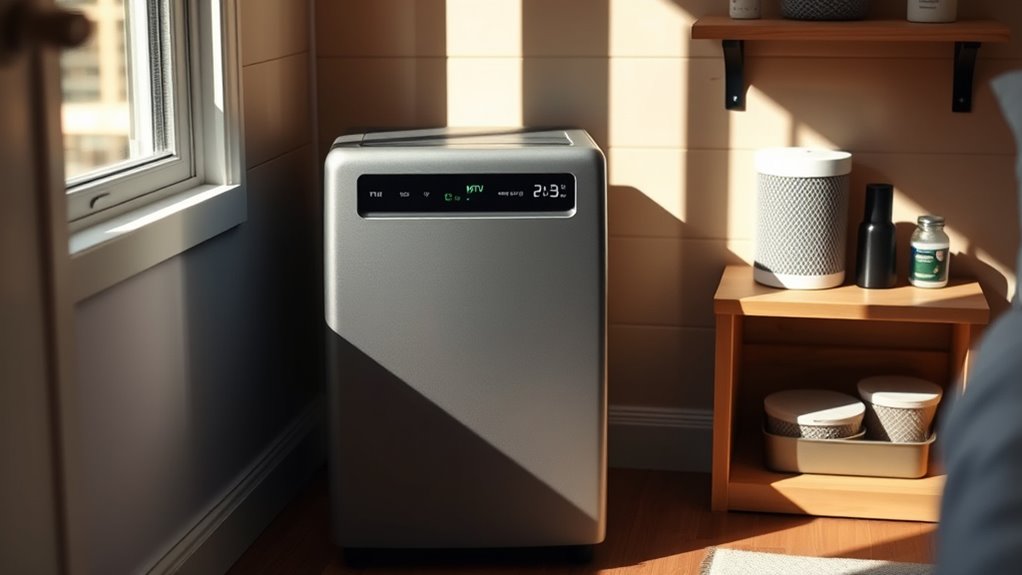
When choosing a portable AC, it’s important to think about noise levels to avoid disrupting your comfort. Regular maintenance, like cleaning filters and inspecting coils, keeps your unit running smoothly and quietly. Understanding decibel levels helps you select quieter models, and by understanding both noise considerations and upkeep needs, you can select a model that lasts and operates quietly. Additionally, selecting units with filter replacement indicators can help ensure timely maintenance and optimal performance over time.
Noise Level Considerations
Evaluating the noise levels of portable AC units is crucial for ensuring they won’t disrupt your environment, especially in bedrooms or workspaces. Most units operate between 50 and 70 decibels, comparable to a normal conversation. Some models can reach up to 75 dB, similar to a vacuum cleaner, which may be too loud for quiet spaces. Quieter options around 52 dB exist but tend to be heavier due to their components. Noise decreases with distance; at 10 feet, it drops to about 55 dB. Factors like unit design, size, and placement influence perceived noise. Advanced technologies and noise reduction features can help minimize disturbance. Remember, the quieter the unit, the better it suits environments requiring peace, but this may come with trade-offs in cooling power. Modern inverter technology also plays a role in reducing operational noise, making quieter units more feasible without sacrificing efficiency. Additionally, sound insulation materials or placement strategies can further reduce noise impact in sensitive areas.
Maintenance and Durability
Maintaining your portable AC unit properly guarantees it runs efficiently and lasts longer. Regularly cleaning or replacing filters prevents clogs that reduce airflow and increase energy use. Empty the condensate tank to avoid overflow and moisture issues. Clean condenser and evaporator coils to prevent dirt buildup, which can cause overheating and performance drops. Keep the exterior free of dust to ensure proper airflow. Inspect and straighten the exhaust hose to maximize efficiency and prevent moisture buildup. Store the unit in a dry place during off-seasons and schedule professional inspections annually. Check seals for leaks and inspect hoses regularly for blockages. Using the right tools, like a vacuum with a brush attachment and coil cleaner, makes maintenance easier. Proper upkeep minimizes common issues like dirty coils, overflowing tanks, and loose seals, extending your unit’s lifespan. Regular filter maintenance is essential for preventing performance issues and ensuring efficient operation. Incorporating filter indicator features can help monitor when filters need attention, further supporting optimal performance.
Proper Installation and Ventilation Tips
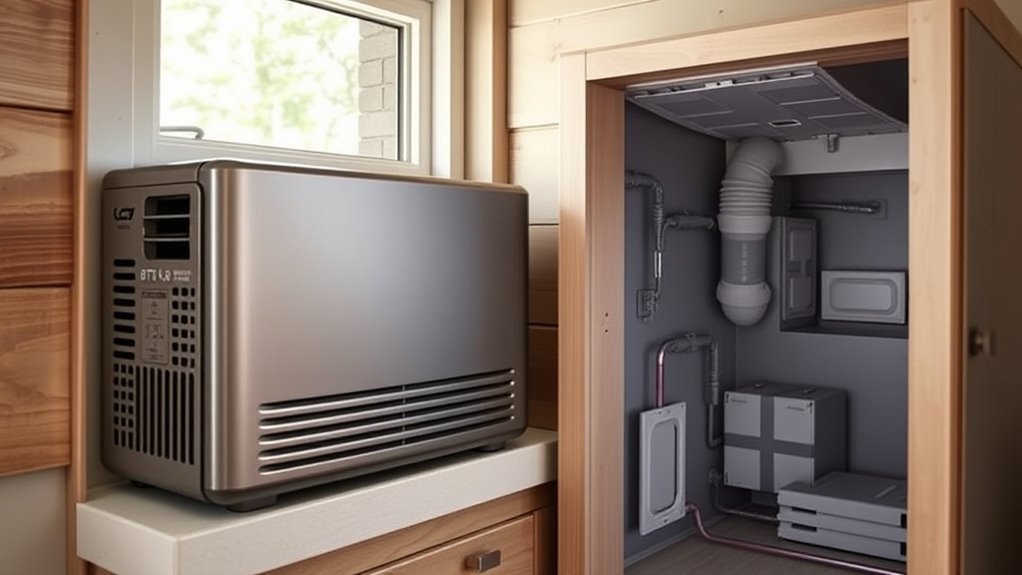
Proper installation and ventilation are crucial for guaranteeing your portable AC operates efficiently and safely. Place the unit near a window and a grounded outlet, avoiding obstructions like furniture or curtains that block airflow. Confirm the exhaust hose connects securely to the window kit, which should be airtight to prevent hot air from entering. Use the included window kit, adjusting it to fit your window, and seal it tightly. Keep the exhaust hose as short and straight as possible; avoid sharp bends to maintain airflow. Maintain clear space around the air intake and outlet, and verify that vents lead outside, not into enclosed spaces. Regularly clean filters and vents, and drain condensate as needed to optimize performance and prevent overheating. Ensuring proper ventilation also helps the unit operate at peak efficiency and extends its lifespan.
Regulatory Compliance and Environmental Benefits
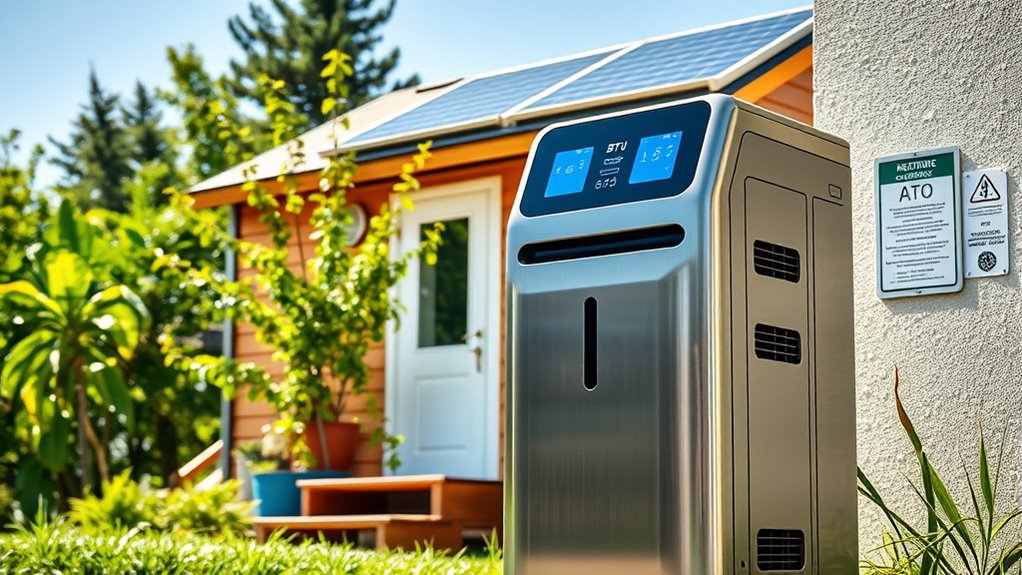
Installing your portable AC unit in a tiny home involves understanding various regulatory requirements that guarantee safety and legal compliance. Tiny homes face unique zoning, building codes, and safety standards that differ by state. Some states, like Texas and Maine, are more permissive, but others impose restrictions on HVAC installation due to safety concerns. Electrical safety standards require proper clearance and ventilation to prevent fire hazards. Building codes may mandate specific safety features, including smoke detectors and carbon monoxide monitors, especially in electrically powered units. Regional regulations also influence the type and efficiency of AC units you can install. Compliance with local building codes can prevent legal issues and potential fines. Adhering to these standards guarantees your tiny home remains safe, legal, and environmentally friendly, especially when choosing energy-efficient models with ENERGY STAR ratings that reduce energy consumption and emissions.
Maximizing Comfort and Efficiency in Tiny Houses
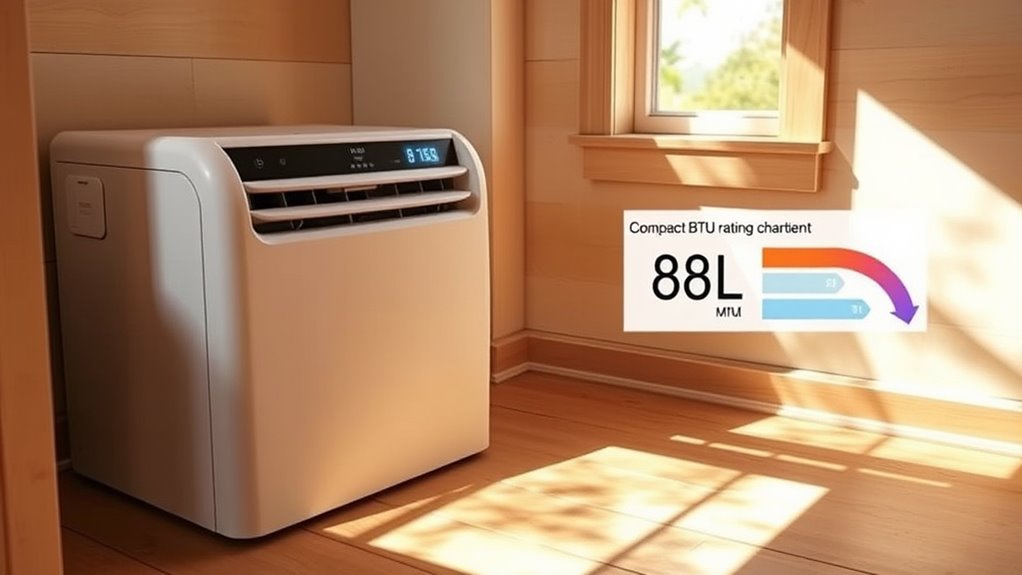
To keep your tiny house comfortable and energy-efficient, choosing the right BTU size and managing ventilation are key. You can enhance cooling by sealing gaps, adding window treatments, and using fans to improve airflow. Regular maintenance and smart use of insulation help maximize your portable AC’s performance and save on energy costs. Proper sizing ensures your unit isn’t overworked or underpowered, which is crucial for maintaining efficiency and comfort in small spaces.
Optimal BTU Selection
Choosing the right BTU rating for your portable AC is essential to maximize comfort and energy efficiency in your tiny house. Generally, aim for at least 9,000 SACC BTUs to ensure rapid cooling, especially in spaces around 150 sq. ft. This higher capacity helps cool the area to a comfortable 72°F faster than units below 9,000 BTUs. Keep in mind, insulation, window exposure, and internal heat sources influence your needs—well-insulated tiny houses with fewer windows may require less. Slightly oversizing the unit can improve cooling speed without wasting energy if you select an efficient model. Avoid oversized units like 14,000 BTUs, which can lead to inefficiency and moisture issues. Prioritize units with good EER ratings and features like dehumidification to optimize comfort and performance. The new SACC ratings provide a more accurate measure of real-world cooling effectiveness, helping you choose a unit that truly performs.
Ventilation Strategies
Effective ventilation plays an essential role in maintaining comfortable and energy-efficient conditions inside your tiny house. To maximize airflow, position windows on opposite walls for cross-ventilation, and consider skylights to boost vertical airflow. Choose operable window styles like casement or awning for flexible control, and install screens to keep insects out while allowing fresh air in. Proper furniture placement helps prevent airflow blockages. Enhance ventilation with energy-efficient exhaust fans in kitchens and bathrooms, and use ceiling fans to circulate air and regulate temperature. Incorporate passive vents, roof vents, and trickle vents for continuous airflow and moisture control. Combining natural and mechanical strategies, along with regular maintenance, assures your tiny house stays fresh, comfortable, and energy-efficient year-round. Proper window placement on opposite walls encourages cross-ventilation and improves indoor air quality.
Energy Conservation Tips
Maximizing comfort and efficiency in your tiny house requires smart energy conservation practices. Use Energy Star-rated appliances to cut energy use without sacrificing functionality, and select compact, low-wattage models like refrigerators and stoves designed for small spaces. Choose appliances with low standby power and opt for multi-functional units, such as washer-dryer combos, to reduce overall consumption. For lighting, replace incandescent bulbs with LEDs, maximize natural light, and install controls like dimmers or motion sensors to minimize unnecessary energy use. Improve insulation with high-quality materials and seal air leaks around doors and windows to maintain consistent temperatures. Set your programmable thermostat wisely, use fans to circulate air, and keep HVAC systems well-maintained. Small changes like limiting shower time and monitoring energy use help you conserve resources while staying comfortable. Additionally, incorporating clerestory windows can significantly enhance natural ventilation and daylight, reducing reliance on artificial cooling and lighting.
Frequently Asked Questions
How Does Portable AC Efficiency Vary Under Different Ambient Temperatures?
You’ll notice that as ambient temperatures rise, your portable AC becomes less efficient because it has to work harder to cool the space. Higher temperatures increase the heat load, reducing cooling capacity and energy efficiency. To maintain comfort, you might need to adjust settings or improve insulation. In cooler ambient conditions, your AC performs better, cooling more effectively and using less energy.
Can Portable AC Units Be Used Alongside Solar Power in Tiny Houses?
You can definitely use portable AC units with solar power in your tiny house. Just make certain your solar system has enough capacity to meet the AC’s power needs, especially during peak sun hours. Using a solar generator with a high wattage rating helps power the AC efficiently. Properly sizing your solar panels and batteries ensures continuous cooling, reduces reliance on grid electricity, and supports your sustainable lifestyle.
What Are the Best Ventilation Practices for Maximum Cooling in Tiny Homes?
Imagine your tiny home as a living organism, breathing with the right ventilation. You should prioritize cross ventilation by placing windows on opposite sides, creating a natural breeze. Incorporate exhaust fans, skylights, and strategically positioned vents to chase away hot air and humidity. Keep pathways clear for airflow, and use moisture management to prevent mold. These practices will help your home stay cool, fresh, and comfortable all year round.
How Long Do Portable AC Units Typically Last With Regular Use?
You’re wondering how long portable AC units last with regular use. Typically, they last between 5 to 10 years, with some reaching up to 10 years if well-maintained. Regular cleaning, avoiding frequent power cycling, and providing proper environment help prolong their lifespan. High-quality units tend to last longer, especially when you schedule routine maintenance. Remember, consistent care and proper use are key to maximizing your portable AC’s longevity.
Are There Portable AC Models Specifically Designed for Tiny House Insulation?
You might think generic portable ACs suit tiny houses, but specific models are designed for ideal insulation use. Brands like ZERO BREEZE Mark 3 and EcoFlow Wave 2 target small, well-insulated spaces, offering ideal BTU ratings and compact sizes. These units ensure efficient cooling, low noise, and energy savings, making them perfect for tiny homes. Their tailored features address the unique insulation challenges, providing comfort without overwhelming limited space.
Conclusion
Choosing the right portable AC for your tiny house might seem overwhelming, but with a little research, you can find a unit that hits the mark. Pay attention to BTU ratings, energy efficiency, and noise levels to keep your space comfortable and eco-friendly. Remember, it’s a bit of a balancing act, so don’t put all your eggs in one basket. With the right info, you’ll be all set to stay cool as a cucumber no matter the weather outside.
I’m Theodore, and I love tiny houses. In fact, I’m the author of Tiny House 43, a book about tiny houses that are also tree houses. I think they’re magical places where imaginations can run wild and adventures are just waiting to happen.
While tree houses are often associated with childhood, they can be the perfect adult retreat. They offer a cozy space to relax and unwind, surrounded by nature. And since they’re typically built on stilts or raised platforms, they offer stunning views that traditional homes simply can’t match.
If you’re looking for a unique and romantic getaway, a tree house tiny house might just be the perfect option.
